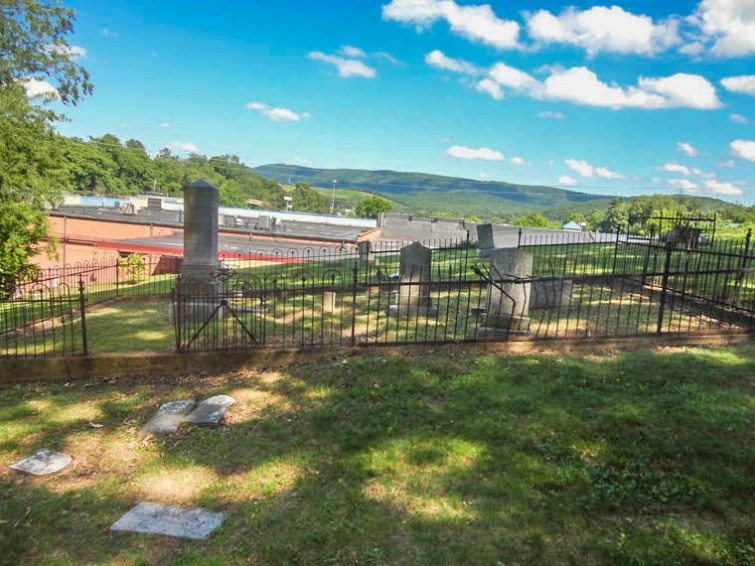Your cart is currently empty!

Old Presbyterian Cemetery: A small piece of history
There is a small piece of Waynesboro history on New Hope Road. Behind the Purple Foot Restaurant, before you get to the Red Brick House, there is a 1.3 acre plot of city-owned land. It is the oldest cemetery in Waynesboro, the Old Presbyterian Cemetery (aka the Old Community Cemetery, the New Hope Road Cemetery).
The Beginning
The old cemetery was associated with the Waynesboro Presbyterian Church, an outpost ministry of the Tinkling Spring Church near Fishersville. A small log church was built in 1798 in the center of the hillside. The church was shared with a Methodist congregation until the Methodists were able to build their own church. In 1824, the log church was taken down and a new brick church was constructed on the same site. That brick church served until a larger one was built in 1876 on the site of the old News Virginian building on Main Street.
The cemetery has a connection to the Revolutionary War, the War of 1812 and the Civil War. In the King family plot is a marker for Sabert King, who was a private in the 7th Virginia Regiment in the Revolutionary War and died in 1838. Alexander Porterfield was a soldier, killed in the War of 1812. There are several Confederate soldiers buried there. George King was a surgeon in the 18thVirginia Cavalry, CSA. There is even an unknown Confederate soldier buried in the cemetery.
Along with the connection to several wars, the Old Cemetery is the final burying place for many prominent Waynesboro citizens. Dr. Dabney Pharr, a pharmacist in the city in the early part of the 20th century, is buried there. Several members of the well-known Plumb family are interred there, too. Those, who are buried in the Old Cemetery, represent a cross-section of Waynesboro life, from the young (James Alexander, died in 1892 at the age of 1month 17 days) to the old (Jacob Imboden, died in 1818 at the age of 81 years). The last known burial was in 1952.
In 1935, the Presbyterian congregation voted to turn over the cemetery to the city. According to an article in the News Virginian at the time, it was given to the city, who agreed to maintain it “as a community shrine”. In 1935, the property had become overgrown and cluttered with debris.
Once the deed had been turned over, I. G. Vass, city manager at that time, utilized Federal relief labor to clean up and make the cemetery “a spot of dignified beauty”. In 1938, a marker was placed on the grave of the unknown CSA soldier. He had died during the Battle of Waynesboro and all efforts to identify him failed.
As the years went by, the cemetery seems to have its ups and downs. When the Center for Shopping was built, part of the property was excavated and regraded. Several graves were moved to the Riverview Cemetery. The oldest remained in their original site. It has been vandalized with gravestones toppled, moved and/or stolen. Many citizens and groups have tried to improve the conditions of the cemetery. In 1975, the Bicentennial Commission erected a flagpole at the gravesite of Sabert King. It is no longer there.
The city has done a good job, routinely mowing the property and cleaning up any debris. Last year, a large oak tree fell and damaged several pieces of iron fencing. These were repaired.
However, much more needs to be done. I don’t think that I can summarize the cemetery’s present condition better than a quote from a News Virginian article dated August 20, 1981: “A heritage-conscious public has looked the other way as a dozen or so 19th-century landmarks have disappeared in a pother of mortar dust…like other remains of old Waynesboro, the graveyard has been neglected, eaten away, irreparably altered and almost forgotten. The tombstones slant sharply, vandals continue to take their toll, and like the city’s history, it slowly but conspicuously fades away.”
A Tribute
To end my column today, I’d like to honor two gentlemen, who were instrumental in preserving local history for the citizens of Waynesboro. Sadly, both recently passed away. I’m speaking of George R. Hawke and Curtis Lee Bowman, Jr. Together, these two men kept the history alive. George Hawke was the author of two large volumes of Waynesboro history, A History of Waynesboro, Virginia to 1900 and A History of Waynesboro, Virginia 1900-1976. Mr. Hawke was a former Chairman of the Historical Commission. Curtis Bowman, Jr. was an honored journalist. Working at The News Virginian, Mr. Bowman wrote ‘Days of Yore”, a column of local history, similar to this column. Some of his writings were ultimately compiled into two history books under the same name. To these gentlemen and all others that have made local history a part of the fabric of this fair city, I give you my thanks.
——
Story originally published June 6th, 2015 in the News Virginian. Written by David Geiger.

Leave a Reply